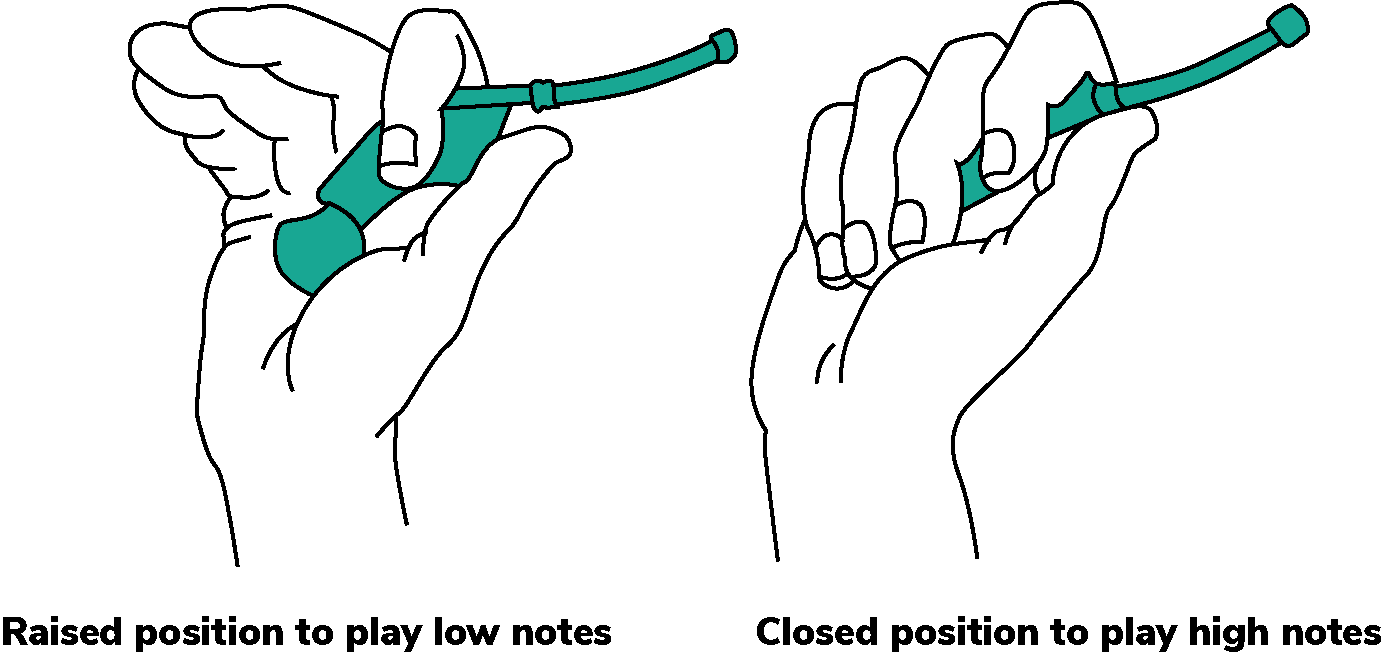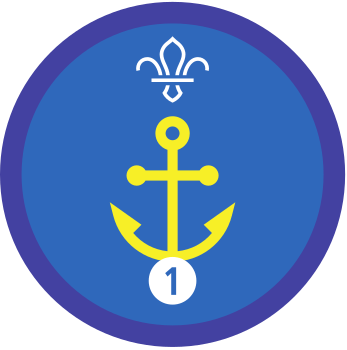
Learn how to make the boatswain’s call
You’ll need
- Boatswain's whistle
- Warm soapy water to clean after use
- Pipe cleaner
Before you begin
- Use the safety checklist to help you plan and risk assess your activity. Additional help to carry out your risk assessment, including examples can be found here. Don’t forget to make sure all young people and adults involved in the activity know how to take part safely.
- Make sure you’ll have enough adult helpers. You may need some parents and carers to help if you’re short on helpers.
Setting up this activity
- A boatswain’s (pronounced ‘bosun’s’) call is a high, powerful whistle designed to be heard over the sounds of the sea.
- Each sound from the whistle is known as a ‘pipe’, and these can be learned simply by listening to them, like the tune to a song.
- You may need more than one whistle, depending on how many different participants would like to play the tune properly.
- If sharing a whistle, it should be cleaned between uses with warm water, soap and a pipe cleaner.
- It’s best to practise outside to prevent hearing damage and help people who may be noise sensitive.
Run the activity
- Explain that everyone will be learning how to use the boatswain’s call. The boatswain’s call has been used by sailors for more than six hundred years!
- Show them the whistles and explain that the call is a high-pitched noise used to attract the attention of sailors at sea. Explain that each different tune on the whistle is called a ‘pipe’.
- Have someone demonstrate some of the commonly used pipes. If no one can play any of them, use this handy guide and audio player made by 4th Gillingham Sea Scouts.
- When everyone’s got a good idea of what the pipes sound like, use the information below to introduce some of these calls and their uses.
- Explain that everyone will now be playing ‘Simon says’ using the boatswain’s call. The group will need to get on with another task, such as a game, activity or even a job like tidying up. A person with the boatswain’s whistle should periodically sound one of the following pipes, and everyone should perform the relevant command:
-
- Still – Everyone should stop where they are and look to the piper.
- Carry on – everyone should go back to what they were doing before (moving around the space)
- Piping the side – everyone should stand at alert and salute.
- The hail (call boatswain’s mates) – leaders or another group of pre-agreed people make their way to the piper, whilst everyone else carries on moving about.
- The haul or hoist – everyone should stand where they are and mime pulling a rope in time.
- Continue to practise the uses of each pipe by taking the boatswain’s call in your right hand between your thumb and index finger, as shown below. The buoy (the round bowl part on the end) should sit in the hollow of your hand and the keel (thin plate along the bottom of the call) should sit in the fleshy part where your thumb joins your hand.
- This next part is much easier with someone who can already play the pipes you’re learning, as they can point out when someone gets it right or wrong.
- If that’s not an option for your group, it may be better to learn the nautical terms that the parts of the boatswain’s call refer to. Make sure everyone understands where each part is first.

- Rest your thumb comfortably along the side of the keel by the shackle (the small ring that the call hangs from). Your index finger should be bent over the top of the gun. The notes of the boatswain’s call are then made by repositioning the other three fingers between the ‘raised’ and ‘closed’ position by covering or revealing the buoy.
- Raising the last three fingers up, away from the buoy as in the first image, frees the airflow through the whistle and produces the ‘low’ note. For low notes, you should blow steadily, but not too hard. Closing the hand to cover the opening of the buoy as in the second image, constricts the air flow, which creates a higher note. You’ll also need to blow a little harder for the high notes.
- One great way to think of this is blowing bubbles. When you blow slowly and steadily, you create larger bubbles making a lower sound. Blowing harder and faster you make lots of smaller bubbles and a higher sound.
- Other than raising or lowering the hand, there are some other techniques you’ll need to know:
-
- The sharp finish. This is done by placing your tongue over the end of the mouthpiece. It should be used only where a sharp finish is required and not between breaths.
- The trill. This is done by putting your tongue to the front of your mouth with the end curled up behind your teeth, and then ‘rolling’ your R’s. It might be easiest to try it without the whistle at first.
- The warble. This is similar to the trill, but not as fast. It’s made by wiggling your tongue up and down or side to side in your mouth whilst blowing.
- Practise the techniques before trying the different pipes out.
‘Still’
- How? Begin with your hand in the closed position, blow the highest note you can for eight seconds, then place your tongue over the mouthpiece for a sharp stop.
- Why? This calls all hands to attention as a mark of respect at ‘Colours’ and ‘Evening Colours’ (raising or lowering the flag), or for a visitor who isn’t entitled to be piped over the side (see piping the side), to gain silence to give verbal instructions or avoid an accident.
- Once the reason for piping ‘Still’ has passed, it’s followed by ‘Carry On’.
‘Carry On’
- How? Begin with your hand in the closed position, blow the high note for one second and then open your hand into the raised position to drop to the low note for one second. Finish by placing your tongue over the mouthpiece for a sharp stop.
- Why? This pipe is used after any verbal orders, or a ceremony that ‘Still’ is used for. It signals that everyone should carry on with what they were doing before, or with the orders they’ve just been given.
‘The Hail’
- How? Begin with the hand in the closed position, blow between five and seven short sharp high notes, or until the person you’re calling acknowledges the pipe.
- Why? This pipe is used to call the Boatswain’s Mate, Coxswain, other staff or the Officer of the Day. The person who’s to be called by this pipe would usually expect it ahead of time, so that everyone else shouldn’t be confused by it.
‘Piping the Side’
- How? Begin with the hand in the raised position, start with a low note and work up to the high note gradually by closing your hand, continue the high note for four seconds then open your hand slowly into the raised position again to finish with a low note.
- Why? Traditionally, this pipe was used to call a team to help a special visitor, like a senior officer or captain, board the vessel on a chair attached to a crane. This was known as the ‘boatswain’s chair’. Most modern vessels carry gangways now, so the crane isn’t used, but this pipe may still be used as a traditional way to greet a special visitor.
‘Haul or hoist’
- How? With the hand in the raised position, begin with a low note for three seconds, moving into a high note with a sharp finish after another three seconds.
- Why? This was originally used to keep sailors pulling together at the same time. The low note is the stand-by and the high note the signal to pull. This is repeated as long as is needed.
Reflection
The first recorded use of the boatswain’s call at sea comes from around the year 1248. For hundreds of years after, closed position (to play high notes) and raised position (to play low notes) was used by sailors everywhere to give orders over the sounds of the sea, where a shout might be lost. This unique method of communication doesn’t rely on those using it to share the same language, only an understanding of the different tunes. What other methods of communication can you think of that don’t use words or sound? Morse code can be transmitted with sound or with pulses of different lengths. Other systems like semaphore use flags to transmit messages. What other systems can you think of? Could you invent a new one?
Safety
All activities must be safely managed. You must complete a thorough risk assessment and take appropriate steps to reduce risk. Use the safety checklist to help you plan and risk assess your activity. Always get approval for the activity, and have suitable supervision and an InTouch process.
- Near water
Manage groups carefully when near water. The guidance on activities near water will help you to keep your group safe.
Increase the challenge by trying out some of the harder pipes to master, like the dinner call! If anyone’s struggling to get the timings of the pipes right, keep practising the techniques and sounds required for each one, as mastering these will make it easier to learn the pipes.
- Those with hearing impairments could use a box worn by the speaker to transmit to hearing aids, but be aware that the high pitch may be uncomfortable.
- Profoundly deaf individuals sometimes use vibrations as a means of communication, so a series of foot stamps linked to the pipes could be devised, or a signer could translate.
All Scout activities should be inclusive and accessible.
Try out the calls for real the next time you take to the water, or on your next camp.
Encourage young people with existing nautical knowledge to share their experience with the rest of the group.
